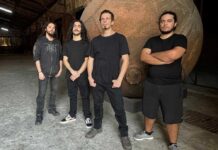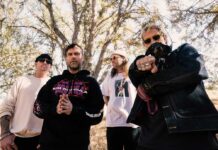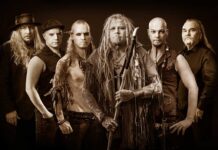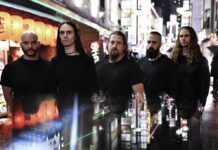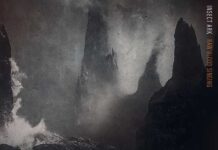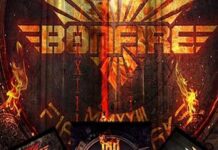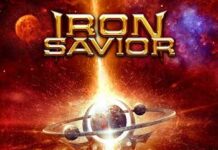
INTERVIEW WITH JAMEY JASTA BY KELLEY SIMMS
PHOTOGAPHS BY JEREMY SAFFER
Hatebreed has set the standard for modern metallic hardcore since its 1994 formation. As one of the most well respected bands in the genre, Hatebreed has carved out a proper career for two-plus decades.
On its eighth full-length album, Weight of the False Self, Hatebreed—vocalist Jamey Jasta, bassist Chris Beattie, drummer Matt Byrne, and guitarists Frank Novinec and Wayne Lozinak—remains a frontrunner of the metalcore/hardcore genre.
Jasta spoke with us during a recent phone interview about the new Hatebreed album, hosting his own podcast show, and a possible new Kingdom of Sorrow record.
Kirk Windstein is all for another Kingdom of Sorrow album. What are your thoughts on a new record and what would it take to make it happen?
Yeah, I’m down! We’ve talked about it a little bit. Now that he’s gotten a solo album out of his system, it’s great. I think Duane [Simoneaux] at OCD Recording did such a great job that between me and Dexters Lab Recording with Nick [Bellmore] and his brother [Charlie] who play in Dee Snider’s band, who also play with us in Kingdom of Sorrow, I think we can definitely do it between the two studios. When Kirk guested on my last Jasta album that came out this past December, I noticed people started searching Kingdom of Sorrow more. And we had dug up some old merch that had been sitting in storage and put it up on Murder Store and it sold out really quickly. There’s definitely more interest in the band now than there was 10 years ago. It’s grown into its own fan base, whereas I think back then the perception of side-projects was of them being lesser. I think fans have gotten past that and they look at those records as two solid records. I have the material and I know he has the material. Now that Hatebreed has a street date for November, we got to get that Crowbar out in February or maybe in March, because it’s done. So, maybe next fall we could get a new Kingdom out and that could be fun.
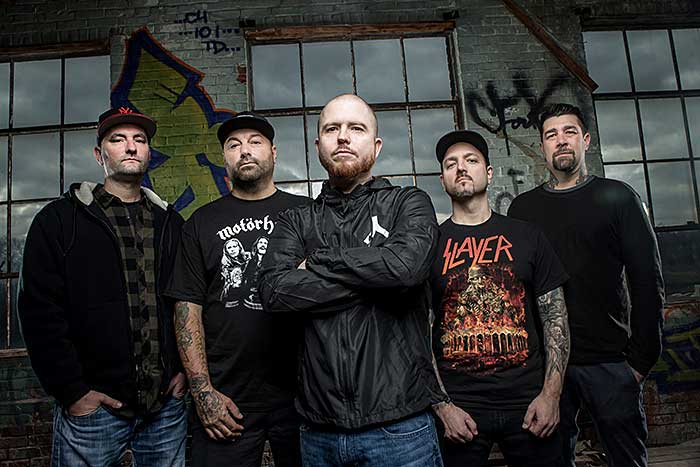
I lived in New Haven during the 90s, remember hearing your first band Jasta 14 on college radio station WHNU, and saw Hatebreed at the legendary Toads Place a few times. Back then, New Haven had a thriving metal/hardcore scene. Are you still active in the Connecticut music scene?
Not really. Once I had my daughter and my sister had her three kids, I just didn’t really have any time. Working with the Bellmore’s and talking to the guys who jam in their other bands and then just talking to people who are in bands locally, I know that the tree that a lot of people think—or at least I think started in New Haven—I know that branch has grown exponentially out to all the different corners of the state and there’s these new little pockets of bands and scenes and even venues. In a way, it’s a little sense of pride because I feel like maybe a ripple that started in the early days with all those bands, not just Blind Justice but even Big Mistake, Malachi Crunch, and Blind Force, I feel like that ripple, that wave that they started that we ended up riding and now that all these other bands are jumping into, I thought that’s cool. I think about the old days and the whole scene and how it was. I’m glad that it’s going to thrive, with or without us. It just seems like it has this momentum now.
“I THINK ABOUT THE OLD DAYS AND THE WHOLE SCENE AND HOW IT WAS. I’M GLAD THAT IT’S GOING TO THRIVE, WITH OR WITHOUT US.”
How did you approach the songs on Weight of the False Self? How did the writing and recording process go?
After the 20th anniversary show we all felt like, “Lets go home and regroup and write some stuff and get together when the time is right.” But once we got offered the Dropkick Murphys/Clutch tour, we thought we can’t really turn down Dropkick. They were nice enough to have us on their St. Patrick’s Day show, and the show went so well and the crowd was so awesome and we did really well on merch that night. A lot of people have never seen us before, and Dropkick is a pretty mainstream band. These were big arenas, too. When we were in Seattle, we were packing up our stuff and I asked Wayne if he had any riffs. I had songs, but a lot of the stuff I had didn’t really feel like Hatebreed, and actually some of it ended up on the Jasta record. He sent me two songs, I think “The Herd Will Scatter” was one of them. And Chris had sent me some cool stuff right when we got back from that tour, the first riff in “Cling to Life.” So, instead of writing from that lyrical standpoint where I would come up with the hook and come up with the vocal, then write the riff underneath it, I actually just placed words over the riffs, which was not something I do a lot, but when I did it on “Cling to Life,” I thought it came out cool.

Speaking of the lyrics, there seems to be a lot of classic metaphors and cool play on words, but are they mostly from personal experiences? What was your lyrical inspiration this time around?
Coming off that tour I was looking through all my different notes. I do a little bit of writing in the pad, but I also was writing in my notepad on my phone. Some of it was so negative and so mean that I couldn’t put it on a Hatebreed record and I didn’t know what to do with these lyrics. I kept some of them. I don’t know if you remember when Snapchat and TikTok first started, but you’d hear about all these different fads and people were dying over the stupidest shit—eating Tide pods and dying, or a guy was jumping in between buildings. When I wrote “Let Them All Rot,” I had those people in mind. I thought, “Is there natural selection or can we educate ourselves to not be so fucking stupid as a society?”
“SOME OF IT WAS SO NEGATIVE AND SO MEAN THAT I COULDN’T PUT IT ON A HATEBREED RECORD”
When I was listening to “Let Them All Rot,” it was so negative, so I had to balance some of the negativity with some positive stuff. I know we have those songs on previous records like “Doomsayer” or “A Call for Blood,” there’s some dark and more pessimistic songs, but mostly we’re known for the more uplifting anthems. So, taking a bunch of that more negative stuff off the record and adding “Set It Right (Start With Yourself),” “Cling to Life,” and “Weight of the False Self,” which ended up being the title track, I felt that gave the record a little more balance.
Weight of the False Self was produced and recorded once again with the help of Zeuss. What were you going for sound-wise on this one, and how has your working relationship and friendship developed over the years?
We’re just very upfront and we know what needs to be done. I said to Zeuss, “If we do this, it can’t be the same old Hatebreed record. We’ve got to clog the guitars, we’ve got to change some of the drum sounds. I don’t want to do any clean singing, I don’t want to do any melody. Let’s make a meat and potatoes Hatebreed record, but let’s also structure it so it’s got a couple of bangers, it’s got some fast, ripping thrash, it’s got some solos. Let’s do the tracks that start with a riff and bass line. Let’s try different amps, let’s try different drums samples, different drum heads, different drum fills.” I think I used to be more from the mindset of let’s be the hardcore AC/DC, like four on the floor, no frills. But once Matt was in there, he was going wild on some of the tracks, and that might not even be noticeable. Some people may listen to the record and go, “They don’t have these ripping metal drum fills that were on The Rise of Brutality or Perseverance.” But we have them on this record, and they complement the riffs.

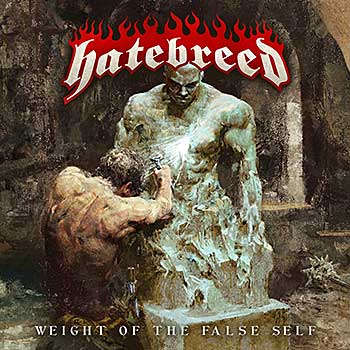
How did you get Eliron Kantor to illustrate the cover, as he’s very in demand as an artist in the metal world. Did you give him much direction on the concept or just let him run with it?
I gave him a bunch of different sketches and explained what the record was about and what we wanted to call it. I had done the same thing with Kirk’s album cover. You love the finished product, but no one sees the work. Nobody sees the sculptor at work, nobody sees the hours upon hours it takes. You just see the success when you get it, you don’t see the 10 years prior or the 20 years prior. How can we put that into a concept based on these sketches, because all I had was the sculptor’s spike with light coming out of it. Just when you think you’re going to quit, then you get that breakthrough, you see the light coming out of the sculpture. It worked well. It was really down to the wire. This is just me being never satisfied with anything, and I always wish that I had a little bit more time and that we could’ve just tweaked a couple of things. But just seeing the preorders and how everyone wants the vinyl or the posters, I feel good that it came out cool and it was an honor to work with him again.
“JUST WHEN YOU THINK YOU’RE GOING TO QUIT, THEN YOU GET THAT BREAKTHROUGH, YOU SEE THE LIGHT”
What was it like VJing on MTV Headbanger’s Ball from 2003–2007? Former host Riki Rachtman still gets shit about the videos that he was made to play, and you never got to pick any of the videos yourself. Did this ultimately become frustrating or did you enjoy that time when you were hosting?
I totally did. I did get feedback, and I did get to squeeze some videos in there. Even on the times that I thought I should make a stink about something, Justin Prager was a good programmer so he had everybody represented. Sure, I could say, “Hey, play more Converge or play more Napalm Death.” But he had put some of those in rotation. Obviously, the lighter stuff that was getting play on regular MTV, I would ask, “Why do they also need to be on Headbanger’s Ball?” But they were right in doing that because if they were a Godsmack fan, even though Godsmack was being played on regular MTV, they might tune in on a Saturday night and then all of a sudden maybe like one of the Lamb of God videos or Avenged Sevenfold. You never know who you’re going to get from that. I think fans, especially the older fans—I would get a lot of messages from parents saying it’s cool and they watch it with their 13-year-old—it was cool to see the generational stuff, and I always told Riki, “Don’t sweat it and to let it go. You kicked down the door for me to walk through and I appreciate it. I’ll always have respect for you, and the majority of the bands have respect for you.” Whatever fans that are still breaking his balls, these are just miserable people that you don’t want to be listening to anyways. I can see where fans were coming from, but you just have to let it go at some point.

About your Jasta Show podcast, what do you like most about it compared to writing, recording, or performing?
Yeah, it’s great. Lately we’ve been going down the rabbit hole of conspiracy theories. I just had Jesse Leach on from Killswitch Engage, and we were talking about all sorts of wild stuff. It’s been fun and it’s one way to stay social, too. During the pandemic, it’s real easy to fall into despair and fall into this mundane routine of not knowing when you’ll go on tour again. But when you break out of it and do a podcast and you actually have an hour-plus conversation with somebody, you can go in a lot of different directions.
“DURING THE PANDEMIC, IT’S REAL EASY TO FALL INTO DESPAIR AND FALL INTO THIS MUNDANE ROUTINE OF NOT KNOWING WHEN YOU’LL GO ON TOUR AGAIN.”
I’ve gotten so many book recommendations, documentary recommendations, and album recommendations from the podcast. And just hearing someone else’s story and also getting to say what I want to say has been fun. We lost a lot of sponsors in the beginning, but now some have come back on board. It’s nice to have another career and know that I got those areas of income covered and revenue coming in. Plus with Patreon, that’s just another added layer of content that I’m able to put out and provide people with value, and that they’re paying every month has been hugely supportive.
Due to the ongoing pandemic and not knowing when you’ll be touring again, what’s the plan for the near future? What are you currently focusing on?
Just focusing on getting this record we produced out and getting that deal done. We’re approaching it like a DIY project where we’re handling a lot of the preorders ourselves. Frank is going to fly up and we’re going to sign all the record covers, and Matt is going to drive down from New York and we’re going to fold up boxes and help assemble all the preorders. In the same period of time, hopefully shoot some videos, and then do the release of our beer cans [Breedbrew]. The canning is happening today. They upped the order because the drafts went so well that now we’re going to do a nonalcoholic version similar to what Lamb of God did. We’re just taking a page from Megadeth, Iron Maiden, and Lamb of God’s book by releasing the beverage. I’m not a big drinker guy—one is too many, but a thousand is not enough. I thought what Lamb of God did was really smart and it’s selling so well. Our drummer Matt and guitar player Chris are real passionate about beer. They’ve been going to the brewery and putting in the work. It’s been a real hands-on project for them and they’re real knowledgeable of it. Just because I don’t drink it doesn’t mean they can’t do it, they’re in the band. Since we’re not touring, they should have this opportunity to do this, and I saw how much people loved it when I was at the first tasting. It was cool to see.




